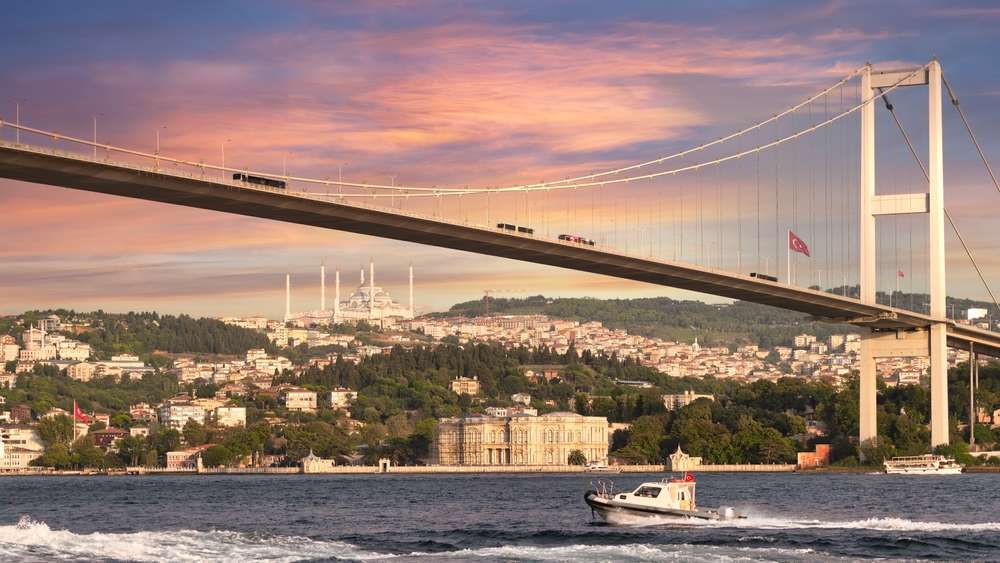
A Comprehensive Overview of the Bosphorus Strait
The Bosphorus Strait, a natural waterway in northwestern Turkey, is a geographical marvel that not only connects the Black Sea with the Sea of Marmara, ultimately linking it to the Mediterranean but also serves as a crucial international passage separating Asia and Europe. With its significant location in Istanbul, the strait not only stands as a vital boundary but also holds a pivotal role in maritime navigation, presenting challenges due to its narrow width, swift currents, and unpredictable winds. This makes the Bosphorus Strait one of the world's busiest maritime passages, underlining its importance to both local and international economies.
The Bosphorus Strait, or the Bosporus, is not just a crucial artery for trade and transportation; it is also a hub of cultural and historical significance. As a place where continents meet, it has been a witness to countless historical events while continuing to be a thriving avenue for sightseeing in Istanbul, attracting visitors with its unique blend of natural beauty and architectural marvels. The formation of the strait and its significance to Turkey underscores its role not only in global commerce but also as a site of rich cultural intersection, making it a fascinating subject for exploration and study.

The Historical Tapestry of the Bosphorus Strait
The Bosphorus Strait has been a pivotal maritime corridor, influencing civilizations and historical events for millennia:
-
Ancient Significance and Conflicts: The strategic importance of the Bosphorus Strait dates back to ancient times, serving as a crucial passageway for seafaring civilizations. The Greeks formed alliances with Byzantium to secure grain transportation through the strait, highlighting its early economic significance. Control over this narrow channel has led to numerous conflicts, including the Russo-Turkish War and the pivotal Battle of Gallipoli during World War I, underscoring its strategic military value.
-
Architectural Marvels and Cultural Heritage: The strait's shores are adorned with historical structures like the Dolmabahçe Palace, the administrative heart of the late Ottoman Empire, and the Rumeli Fortress, built to control naval traffic. These landmarks, along with the Hagia Sophia Museum and Maiden's Tower, not only offer breathtaking views but also narrate the rich cultural tapestry of the region.
-
Crossroads of Civilizations: Over 3,000 years, the Bosphorus Strait has witnessed the rise and fall of empires, from the Greeks and Romans to the Ottomans. King Darius the Great's monumental crossing and the Ottoman conquest of Constantinople in 1453 are testament to its enduring geopolitical relevance. These events marked significant historical shifts, influencing the Renaissance and the Age of Discovery.

Why Bosphorus Strait is so important to Turkey
Understanding the significance of the Bosphorus Strait to Turkey and its sightseeing allure is crucial for appreciating its global importance:
-
Formation and Historical Significance: The formation of the Bosphorus Strait is a geological marvel, resulting from complex natural processes over millennia. This strait not only demarcates the boundary between Europe and Asia but also has been a crucial channel for naval navigation and trade since ancient times. Its strategic location has imbued it with immense historical and economic value, influencing the rise and fall of empires and facilitating cultural exchanges between continents.
-
Economic Lifeline: The Bosphorus Strait is vital for Turkey's economy, serving as a key maritime route for international trade. It is especially significant for the transportation of oil and natural gas, making it a critical artery in the global energy market. The revenue generated from transit fees and its role in international logistics underscores its economic importance to Turkey.
-
Sightseeing and Cultural Significance: The Bosphorus Strait is a top sightseeing destination in Istanbul, offering breathtaking views and a unique blend of natural beauty and architectural splendor. From historic palaces and fortresses to modern bridges and bustling waterfronts, the strait presents a tapestry of Istanbul's rich cultural heritage and modern vibrancy. Sightseeing cruises along the Bosphorus offer an unparalleled perspective on the city's historical landmarks and scenic landscapes, making it a must-visit for travelers and a source of pride for locals.

A Hub of Cultural Intersection
The Bosphorus Strait, a beacon of cultural confluence, boasts an array of historical and architectural marvels, each narrating a unique story of Istanbul's rich past and present. Among these, the Hagia Sophia and the Topkapi Palace stand as monumental landmarks, drawing visitors from around the globe to marvel at their intricate designs and historical significance. These sites not only embody the architectural genius of their eras but also serve as a testament to the diverse cultural influences that have shaped Istanbul.
- Notable Architectural Marvels:
Ortaköy Mosque: Known for its breathtaking location under the Bosphorus Bridge, this mosque captivates with its blend of Neo-Baroque and traditional Ottoman architecture, offering panoramic views that symbolize the strait's beauty.
Süleymaniye Mosque: As one of Turkey's largest mosques, it showcases a fusion of Byzantine and Islamic architectural elements, reflecting the geometric intricacies and artistic depth of Islamic art.
The strait's shores are adorned with historical edifices, from the grandeur of Ottoman Palaces like the Yildiz and Hatice Sultan Palaces to the strategic Rumelihisari fortress, each contributing to the strait's narrative as a center of power and beauty. Additionally, the picturesque Yalis, waterfront villas built for the Ottoman elite, and the evolving architectural landscape visible from the Asian side of the strait, offer a glimpse into the opulent lifestyle of the past and the seamless blend of tradition and modernity that characterizes Istanbul today. This rich tapestry of cultural landmarks underscores the Bosphorus Strait's role as a pivotal hub of cultural intersection, inviting exploration and discovery.
sightseeing of Bosphorus strait
Exploring the Bosphorus Strait offers a multifaceted journey through Istanbul's vibrant life and history. Here are key sightseeing highlights:
Bosphorus Cruise: Embarking on a cruise along the Bosphorus Strait is an unparalleled way to witness Istanbul's dynamic skyline and the seamless blend of Europe and Asia. This voyage presents a unique opportunity to view many of Istanbul's historical sites from a fresh perspective, making it a favorite among visitors.
Ferry Cruise: Opting for a ferry cruise provides a closer look at the bustling activities along the strait's edges. It's a chance to experience the city's heart from the waters, connecting two continents while enjoying the picturesque views of Istanbul's skyline.
Landmarks and Attractions:
Galata Tower: This nine-story medieval stone tower offers a panoramic view of Istanbul, accessible via two working elevators, ensuring visitors can easily reach the top for a breathtaking 360-degree cityscape.
Istanbul Aquarium: Among the world's leading aquariums, it boasts a diverse collection of sea life, organized in region-specific tanks. It's an educational and fascinating visit for all ages, highlighting the aquatic wonders from various parts of the globe.
The shores of the Bosphorus are lined with exquisite neighborhoods, historical palaces, fortresses, and villas, each narrating their own story of Istanbul's past and present. This rich tapestry of sites makes sightseeing in the Bosphorus Strait an essential experience for understanding Istanbul's cultural and historical significance
FAQs
What is the significance of the Bosphorus Strait? The Bosphorus Strait is critical due to its unique position as the sole maritime corridor between the Black Sea and the Mediterranean Sea, which has made it a key commercial and military route throughout history. Today, it continues to be a strategic channel, especially for countries like Russia and Ukraine that rely on it for sea access.
Can you describe the Bosphorus Strait? The Bosphorus Strait is a natural channel linking the Black Sea with the Sea of Marmara. It bisects the city of Istanbul into European and Asian sections, with Europe to the west and Asia to the east.
Could you provide a brief history of the Bosphorus Strait? The Bosphorus Strait is believed to have been formed around 5600 BC when rising waters from the Mediterranean Sea and Sea of Marmara broke through to the Black Sea, which at that time was a lower-level freshwater body, according to the hypothesis.
Why is the Bosphorus considered a vital waterway? The Bosphorus is a crucial waterway because it demarcates the continents of Europe and Asia. It also divides Turkey into its European part, known as Thrace, and its Asian part, called Anatolia. The strategic importance of straits like the Bosphorus has been recognized historically due to their geopolitical and economic significance.
Conclusion
Throughout the exploration of the Bosphorus Strait, we have traversed its historical significance, marveled at its geographical idiosyncrasies, and recognized its pivotal role in not only Turkey's economic and strategic positioning but also as a centerpiece for cultural confluence and architectural ingenuity. The strait's formation and the engineering marvels that bridge its shores illuminate the harmonious blend of natural beauty and human innovation, enhancing its allure to both locals and tourists alike. This compelling narrative not only highlights the Bosphorus Strait's importance to Turkey but also underscores its global significance as a crucial maritime passage and a hub of historical and cultural intersection, inviting further exploration and appreciation.
The Bosphorus Strait, with its bustling waterway and picturesque vistas, continues to fascinate those who venture to its shores, offering a unique perspective on Istanbul's vibrant history and its modern-day charm. As a crossroads of civilizations and a beacon of connectivity between continents, the Bosphorus stands as a testament to the enduring spirit of exploration and discovery. It encourages us to delve deeper into the stories that weave the fabric of this remarkable region, inviting us to read more about its wonders and embark on a journey of our own. The significance of the Bosphorus Strait transcends time, promising endless fascination and insights for the next generations.
Related Tours








































